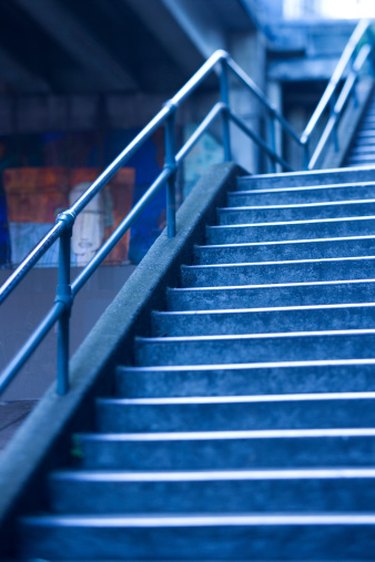
Climbing stairs is, for many people, a daily activity while for others it is also an effective form of exercise. Athletes from a variety of sports use stair climbing as a conditioning workout and it is not uncommon to see people running up and down stadium or office building stairs. There are also numerous races up long flights of stairs. One of the most well-known and popular is the annual Empire State Building race that involves running up 86 flights, a total of 1,576 steps and a gain in altitude of about 1,200 feet.
Muscles that Extend the Hip
Video of the Day
Hip extension is a major component in walking up stairs. You can increase the degree of hip extension you experience by taking the stairs two at a time or by running up the stairs. Your have two primary hip extension muscles -- your gluteus maximus and your hamstrings, both located on the rear of your hip/thigh. As these muscles contract, they drive your femur or thigh bone backward to provide forward and upward momentum.
Video of the Day
Knee Extension
Climbing stairs requires active knee extension. The degree of knee extension depends on the height of each stair. A higher stair will require you to bend your knees more deeply and the greater the amount of knee flexion, the greater the involvement of your knee extensor muscles -- the quadriceps. Your quadriceps are located on the front of your thigh, originating near your hip and terminating just below your knee. These are the muscles that can feel tired and hot as you climb a long flight of stairs.
Hip Flexion
As you climb stairs, you must swing your leg from an extended position and into a flexed position in preparation for another stride. This is the job of your iliacus, psoas major and psoas minor. Collectively these muscles are called iliopsoas and are located on the front of your hip. In addition to extending your knee, one of the quadriceps, rectus femoris, also flexes your hips as your swing your leg forward and up onto the next step.
Ankle Platarflexion
Extending your ankle, correctly called plantarflexion, is the job of your calf muscles -- specifically soleus, gastrocnemius and tibialis posterior. These muscles work to keep your ankle braced as your climb the stairs so that the energy produced by your leg muscles is not wasted. They also provide assistance as they extend your ankle which results in a strong push off from the balls of your feet.
The degree of involvement of your calf muscles in stair climbing depends on how much you push off the balls of your feet. If you climb the stairs using a flat footed technique, there will be relatively little in the way of calf muscle work. If, however, you actively push off your toes, for example when running up stairs two at a time, your calf muscles will have to work much harder.